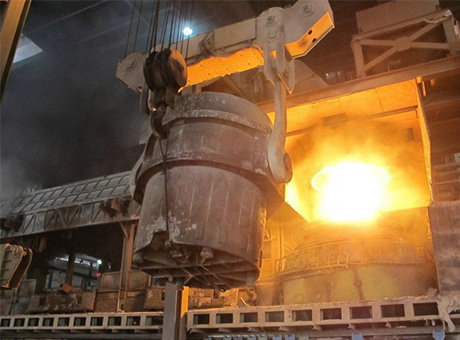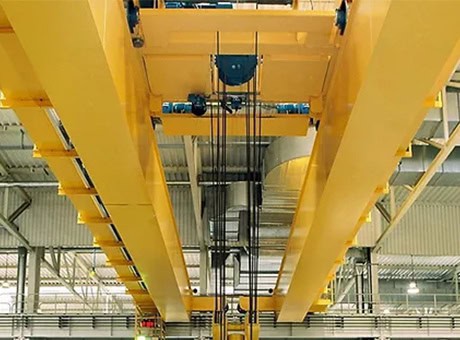First: General bridge crane
General-purpose bridge cranes are bridge cranes that work in general environments, and their pick-up devices are hooks or grabs or lifting electromagnets (electromagnetic chucks), or two or three of them are used at the same time
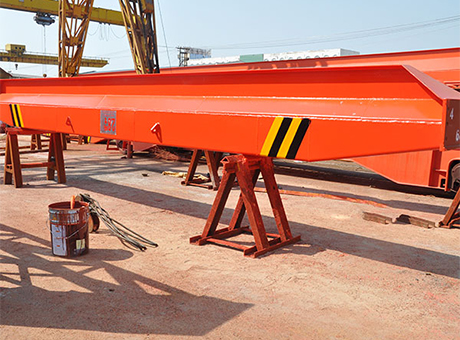
1. Basic composition of general bridge crane
The general bridge type includes annual operating mechanism, lifting trolley, driver’s cab, electrical system and safety protection devices, etc.
(1) The bridge frame includes the main beam and the main beam, and the trolley track is fixed on the main beam. The main girder should have a camber. After my test, when the main car is in the limit position, the highest point of the camber should be within the range of S/10 (S is the span) in the middle of the span, and its value should not be less than 0.7S/1 000. The end girder is a component supporting the bridge girder composed of plate girders or trusses, wheel sets, etc.
(2) The traveling mechanism of the cart includes motors, reducers, brakes, transmission shafts, couplings and wheels, etc., which are used to drive the wheels of the cart to rotate and run horizontally along the crane track.
(3) The lifting trolley is an assembly that moves the suspended load, and is composed of a trolley operating mechanism, a lifting mechanism and a trolley frame. The trolley running mechanism is mainly composed of motor, reducer, brake, transmission shaft, coupling and wheels, etc., which undertake the lateral movement of the crane; the lifting mechanism is composed of motor, reducer, brake, reel, fixed pulley block and lifting wire rope Composition, undertake the lifting movement of the lifting operation; the trolley frame is generally composed of steel plate and section steel welded, and bears and transmits all the lifting load.
(4) All control equipment of the crane, as well as signal and lighting equipment, are arranged in the driver’s room, which are operated and controlled by the driver.
(5) The crane is powered by slide wire and brush. The three-phase AC power supply is connected to the main slide line erected along the length direction of the trolley track, first introduced into the main power switch in the cab through the brush, and then supplies power to the electrical equipment of the crane, and the trolley is powered by the auxiliary slide line. Small cranes are powered by flexible cables.
(6) The installation requirements of the safety protection devices on the bridge crane are as follows: The safety protection devices that should be installed include lifting weight limiters, lifting height limiters, descending depth limiters (as required), and operating stroke limiters. , interlock protection safety device, buffer, anti-wind anti-skid device (outdoor work), track cleaner, end stopper, conductive slide wire protection plate, protective cover for moving parts of the basket, rainproof for electrical equipment Cover (when the protection level of outdoor work cannot meet the requirements), the safety protection devices that should be installed include operation alarm devices and anti-collision devices.
2. Working characteristics and uses of general bridge cranes
The working space of the general bridge crane is a box-shaped space with a fixed span, which does not occupy the usable area of the ground.
General-purpose bridge cranes are mainly used for material handling in indoor machinery manufacturing and processing workshops, assembly workshops, warehouses, stockyards, etc., lifting of fixed maintenance equipment such as power plants and other occasions, and can also be used in metallurgy and foundry workshops as auxiliary lifting equipment, etc. . Not suitable for flammable, explosive, flammable gas, dust and corrosive gas environment, not suitable for nuclear radiation environment, toxic gas environment.
Second: Electric hoist bridge crane
The electric hoist bridge crane is a general-purpose crane with an electric hoist as the lifting mechanism, and the main girder is a double girder, as shown in Figure 2-7.
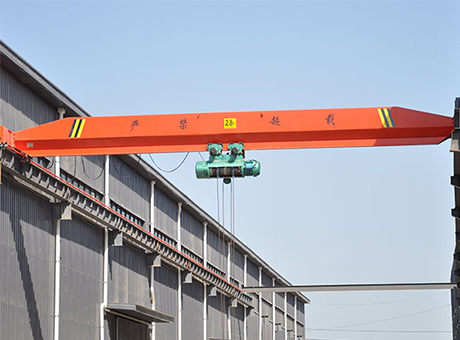
1. The type and basic composition characteristics of the electric hoist bridge crane
Electric hoist bridge cranes can be divided into electric hoist hook bridge cranes, electric hoist grab bridge cranes, and electric hoist electromagnetic bridge cranes according to the pick-up device; according to the operation mode, they can be divided into cab manipulation and ground Manipulation, where ground manipulation includes follow-up and non-follow-up manipulation of button devices (flashlight doors) and remote control manipulation.
Except that the hoisting mechanism adopts the electric hoist and its feeding method, the basic composition of the electric hoist bridge crane is the same as that of the general bridge crane, and the requirements for the setting of safety protection devices are the same
2. The use of electric hoist bridge crane
Electric hoist bridge cranes and electric single-girder cranes have the advantages of compact dimensions and low building headroom, which are suitable for production, processing, assembly workshops, factory maintenance operations, loading and unloading operations in warehouses, stockyards, etc., and have a wide range of applications.
3. Requirements for the working environment of the electric hoist bridge crane
(1) The power supply of the crane is three-phase alternating current, the rated frequency is 50Hz or 60Hz, and the rated voltage is 220-660V. The upper and lower limits of the allowable voltage fluctuation on the motor and electrical control equipment are ±10%, and the internal voltage drop of the crane is not more than 5%. .
(2) Cranes generally work indoors. The working environment temperature is -20 ~ 40 ℃, and the average temperature within 24 hours does not exceed 35 ℃. When the average temperature within 24 hours does not exceed 25°C, the relative humidity is allowed to temporarily reach 100%; at a temperature of 40°C, the relative humidity should not exceed 50%.
(3) The operating conditions of the motor should comply with the regulations of “Rating and Performance of Inch-rotary Motors” (GB/T755-2019).
(4) The normal use, installation and transportation conditions of electrical appliances shall comply with the provisions of “Low-voltage Switchgear and Control Equipment Part 1: General Rules” (GB 14048.1-2012)
(5) The installation of the running track of the crane shall comply with the provisions of the tolerance part 1 of the crane wheel and the track tolerance of the cart and trolley; General Rules (GB/T10183.1-2018)
(6) Not suitable for practical dust and corrosive gas environment, not suitable for lifting molten metal, flammable and explosive items
the
Third: Explosion-proof bridge crane
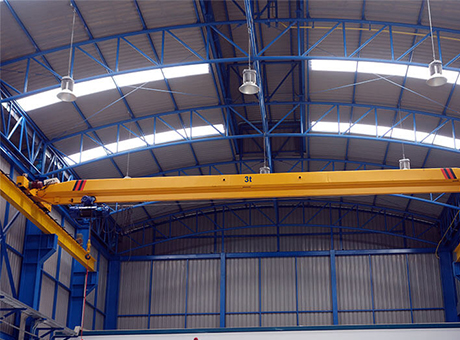
1. Classification of explosion-proof cranes
The electrical equipment for explosion-proof cranes used in explosive environments is divided into categories I, II, and III, and the corresponding explosion-proof cranes are also divided into three categories.
Class I: Explosion-proof cranes for coal mine gas environment.
Class II: Explosion-proof cranes for other explosive gas atmospheres other than coal mine gas.
Class III; Explosion-proof cranes for explosive dust environments other than coal mines.
Class II explosion-proof cranes can be further divided into Class II A (representative gas is propane), Class II B (representative gas is ethylene), and Class II C (representative gas is hydrogen) according to the type of explosive gas environment in which they are located. Explosion-proof cranes. Class III explosion-proof cranes can be further divided into Class III A (explosive dust is combustible flying catkins), Class III B (explosive dust is non-conductive dust) and Class III C (explosive dust is Guided dust) explosion-proof cranes.
The operating class of explosion-proof cranes should not exceed A5. When the explosion-proof classification is Ⅱ C, Ⅱ B, Ⅲ C, the running speed of the crane and the trolley should not exceed 16 m/min, and the running speed of the crane and the trolley of other explosion-proof classifications should not exceed 25 m/min. The lifting speed of the crane should not exceed 8m/min, and the speed of the wire rope should not exceed 28m/min.
2. Explosion-proof requirements for explosion-proof bridge cranes
(1) The requirements for material selection are as follows;
a. The material of the important welding components of the crane metal structure (such as the main girder, end girder, trolley frame, etc.) should be killed steel. the
b. The product nameplate and tonnage plate must be made of brass or stainless steel, and the thickness of the product nameplate should not be less than 1 mm. The thickness of the bit plate should not be less than 3mm.
c. When the explosion-proof classification is Ⅱ C, Ⅲ B, Ⅲ C, the wheel tread and rim parts should be made of copper alloy or other materials that will not ignite the explosive gas mixture due to impact and friction.
d. The touch wheel on the limit switch and the roller of the cable block should be made of bronze or brass or engineering plastics whose surface resistance is not greater than 109Ω. When the explosion-proof classification is Ⅱ C, Ⅲ B, Ⅲ C, the traction line of the cable block should use stainless steel wire rope.
e. The device to prevent the wire rope from falling off the groove shall be made of non-sparking material.
(2) The requirements for main parts and components are as follows:
a. Open gear transmission should not be used.
b. The hoisting mechanism should have two sets of explosion-proof brakes, and an explosion-proof lifting weight limiter should be installed.
c. The buffer should be a polyurethane buffer that complies with the provisions of “Polyurethane Buffers for Cranes” (JB/T 10833-2017) or a rubber buffer that complies with the provisions of “Rubber Buffers for Cranes” (JB/T 12988-2016). Surface resistance should not be greater than 10Ω.
d. There should be no broken wires in the wire rope.
e. When the explosion-proof classification is II C, the hook should take measures to prevent sparks from impact or friction.
f. Large and trolley tracks should adopt welded joints, and the joints should be smooth. Otherwise, the lateral displacement and height difference at the joint of the two tracks shall not be greater than 0.5 mm, and the joint gap shall not be greater than 1 mm. The contact surface between the wheel and the track should be free of rust and well grounded to avoid sparks due to corrosion.
g. The outer surface of the side plate of the hook pulley block should be marked with warning words, such as “no touch to the ground, collision” and so on.
(3) The requirements for electrical equipment are as follows;
a. The selection of electrical equipment should comply with the provisions of “Explosive Atmospheres Part 1: General Requirements for Equipment” (GB 3836.1-2010) and “Electrical Equipment for Combustible Dust Environments Part 1: General Requirements” (GB 12476.1-2013), Its performance should meet the requirements of the user for explosion-proof type and maximum surface temperature.
b. Large and trolley feeders should use soft cables to conduct electricity. The connections between electrical equipment must use rubber-sheathed copper core multi-strand round cables. The power supply cable of the crane should be a cable with a ground core.
c. The lead-in devices of all explosion-proof electrical equipment shall adopt the cable sealing ring type, and each lead-in device is only allowed to lead in one rubber-sheathed round cable. The wiring adopts rubber-sheathed copper core multi-strand round cables, no joints are allowed in the middle, and a coal junction box can be set up if necessary.
d. The switch should be flameproof, and the warning signal should be intrinsically safe. the
3. Requirements for working environment conditions of explosion-proof bridge cranes
(1) Cranes generally work indoors (negotiation between the supplier and the buyer when working outdoors), the working environment temperature is -20 ~ 40 ℃, and the working environment air pressure is 0.08 ~ 0.11MPa
(2) The environment in which the crane is used should have good ventilation and necessary facilities.
(3) The gas environment coal prevention hazardous area applicable to the crane is Zone 1 or Zone 2 as defined in “Explosive Atmospheres – Part 14: Location Classification – Explosive Gas Atmospheres” (GB 3836.14-2014).
Explosive gas atmosphere refers to atmospheric conditions. An environment in which a mixture of a combustible substance in the form of a gas or vapor and air is ignited and can maintain the self-propagation of combustion
Zone 1 is an area where an explosive gas atmosphere may occasionally occur during normal operation.
Zone 2 is an area where, during normal operation, an explosive gas atmosphere is unlikely to occur (if it does, it will only exist for a short period of time).
(4) The dust environment explosion-proof hazardous areas applicable to cranes are Area 21 and Area 22 specified in “Electrical Equipment for Combustible Dust Environments Part 1: General Requirements” (GB 12476.1-2013).
Explosive dust environment refers to the environment in which the mixture formed by dust, fiber or flocculent combustible substances and air is ignited under atmospheric conditions, and the combustion will spread to all unburned mixtures.
Area 21 is in progress. An example of a place where an explosive atmosphere in the air may appear or occasionally appear in the state of a combustible dust cloud may produce a zone 21 is as follows; when a mixture of explosive dust and air appears inside the dust container, in order to move or open the nearest Locations outside dust containers; when measures are not taken to prevent the formation of explosive dust-air mixtures, in locations outside dust containers closest to loading and unloading points, feed belts, sampling points, truck unloading stations, belt unloading points, etc. .
Zone 22 refers to a place where, during normal operation, an explosive atmosphere in the air is unlikely to occur in the state of a cloud of combustible dust (if it does, it will only exist for a short period of time). Examples of places that may generate Zone 22 are as follows; the exhaust port of the dust bag filter vent, if it fails, it may escape an explosive dust and air mixture.
4. Special requirements for the use of explosion-proof bridge cranes
Operators should be familiar with explosion-proof related knowledge, be familiar with and master the performance characteristics of explosion-proof bridge cranes and use them correctly, and should pay attention to the following:
(1) The operating mechanism of large and small vehicles should be stable during the starting and braking process to avoid wheel slippage and visible sparks.
(2) The lifting wire rope should ensure reliable lubrication to reduce the friction between the wire rope and the reel, pulley and explosion-proof electric hoist rope guide.









